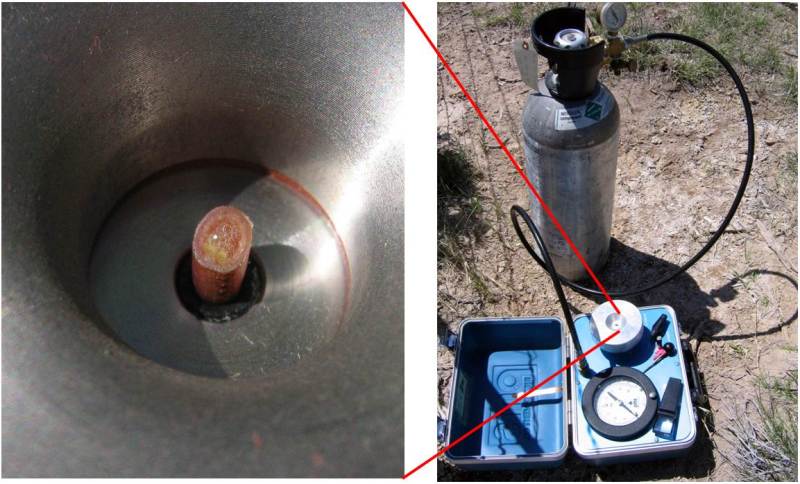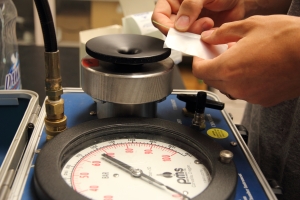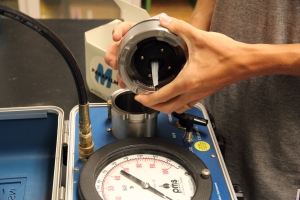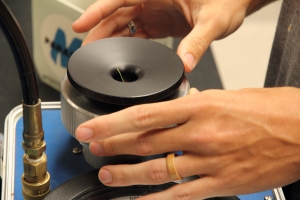
This is how I did it… coaxing xylem water out of wimpy leaves
Here’s a trick for anyone out there using pressure chambers to measure plant water stress. It’s quite simple, yet somehow evaded me in over 5 years making plant physiology measurements…
A pressure chamber (aka pressure “bomb”) measures leaf or stem xylem water potential, or the amount of tension on water in a plant’s water-conducting vessels (xylem). This is done by raising the pressure on the plant leaf or stem until xylem water is forced out of the top when pressure and tension equilibrate.

A plant under drought stress will hold water under much stronger tension compared with a well-watered plant, so the measurement is often used to compare plant water stress among multiple species, or a single species at multiple points in time or across experimental treatments. In general, it’s a really nifty and straightforward measurement to make, but because leaves vary widely in shape, dimensions, and toughness, custom adjustments are often essential…
Working with plants in arid environments, I’ve routinely measured xylem water tensions 10, 20, or even 30 times as great as the pressure in a typical car tire. That’s a tremendous amount of force, and it still amazes me that some plants’ xylem vessels are built to handle it! Still, some leaves are too fragile to withstand both the chamber pressure AND the compression force holding them inside the rubber stopper in the chamber lid. Such leaves can rip in half, severing the xylem vessels before the water appears, which prevents a water potential measurement. In my experience, this can be a real problem with grass blades, particularly under drought conditions. I’ve worked with grasses in Colorado’s dry San Luis Valley, and some days, leaf after leaf would fail inside the chamber in the higher pressure range, triggering a string of expletives that could’ve made a sailor blush, and ultimately leaving me with a few missed data points in spite of the effort.
 Recently, I re-visited this challenge while measuring grasses at the PHACE experiment in southeastern Wyoming. The most ecologically important species in our system, blue grama (Bouteloua gracilis), also has the most delicate leaves–leaves which curl and become increasingly brittle during hot, dry periods (such as late June 2013 in our area). Our first several attempts to measure xylem water potentials on blue grama ended with a pile of ripped leaves, leaving us data-less and sad.
Recently, I re-visited this challenge while measuring grasses at the PHACE experiment in southeastern Wyoming. The most ecologically important species in our system, blue grama (Bouteloua gracilis), also has the most delicate leaves–leaves which curl and become increasingly brittle during hot, dry periods (such as late June 2013 in our area). Our first several attempts to measure xylem water potentials on blue grama ended with a pile of ripped leaves, leaving us data-less and sad.
 Fortunately, the scientists I was working with, Kevin Mueller (USDA-ARS) and Troy Ocheltree (CSU), had a troubleshooting strategy in mind: wrap the leaf blades in Parafilm, which protects the fragile tissue and reduces friction along the insides of the rubber stopper. For our blue grama samples, the Parafilm trick saved our leaves from ripping about 90% of the time. No Parafilm handy? Grocery store plastic wrap would probably do just about as well…
Fortunately, the scientists I was working with, Kevin Mueller (USDA-ARS) and Troy Ocheltree (CSU), had a troubleshooting strategy in mind: wrap the leaf blades in Parafilm, which protects the fragile tissue and reduces friction along the insides of the rubber stopper. For our blue grama samples, the Parafilm trick saved our leaves from ripping about 90% of the time. No Parafilm handy? Grocery store plastic wrap would probably do just about as well…
Not exactly rocket science, but it WORKS!
For more helpful tips & tricks, check out this link and more at the PrometheusWiki website. For more EcoPress posts on the PHACE experiment, see here and here.
Special thanks to Kevin Mueller for contributing his SWEET hand-modelling skills.